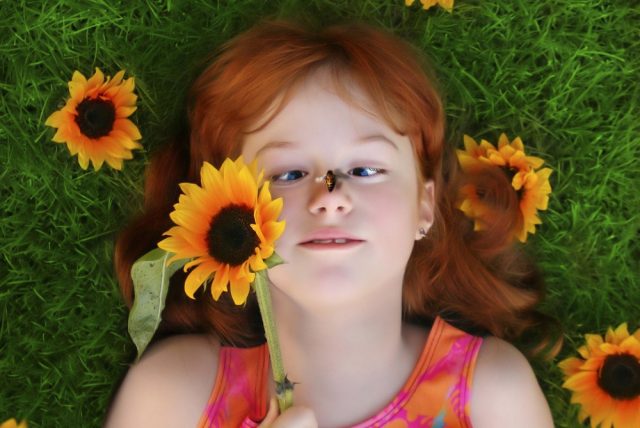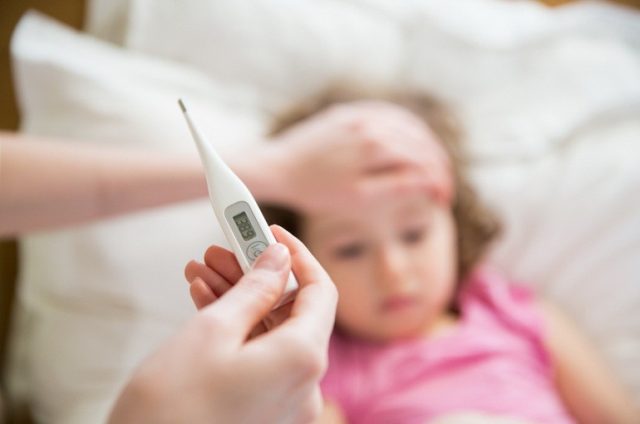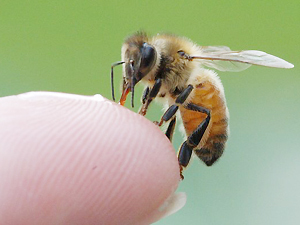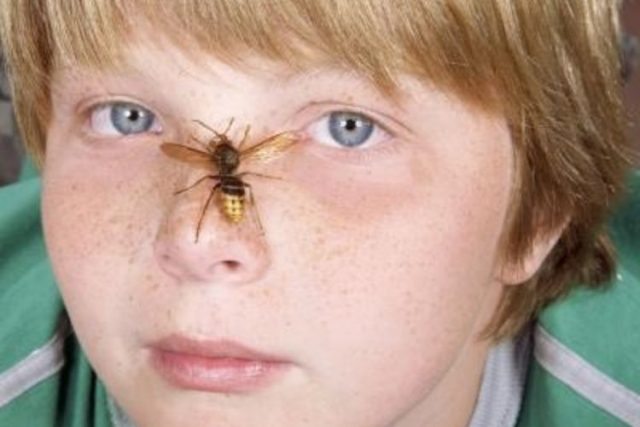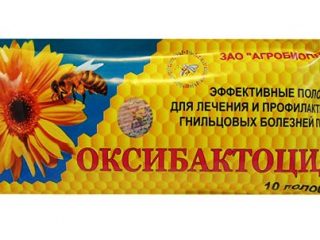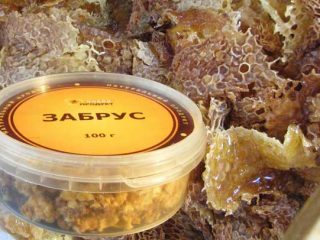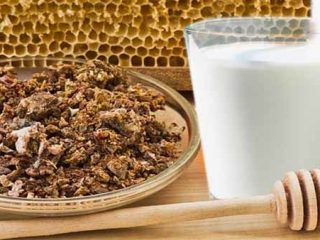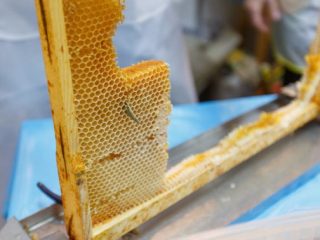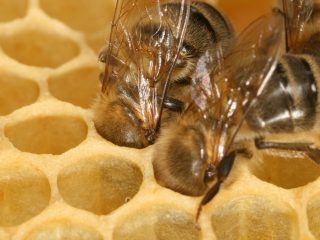Content
Every year, many children and adults experience negative consequences from bee and wasp stings. The effects of bites vary: from slight redness on the skin to anaphylactic shock. If a child has been bitten by a bee, it is necessary to immediately provide him with first aid.
Why is a bee sting dangerous for a child?
Pain and burning are caused not by a puncture by a tiny bee or wasp sting, but by the insect's sting itself getting under the skin. The sting releases bee venom (or apitoxin). This is a very complex substance in its structure, which is a whole cocktail of hydrochloric and phosphoric acid, as well as other specific biological substances.
For example, a toxin such as melitin leads to the destruction of red blood cells, increases vascular permeability and helps the poison spread faster in the body.Histamine, which is also part of bee venom, is a strong allergen. This substance is the cause of severe swelling.
Attention! Histamine can cause contraction of the bronchi in a child, dilation of blood vessels, and lead to a rapid decrease in blood pressure. Therefore, if a child is bitten by a bee, you should immediately contact your pediatrician!
The excitation of all nerves is promoted by the substance apamin. Hyaluronidase causes rapid swelling due to the destruction of hyaluronic acid, an element of connective tissue. Phospholipase A2 damages cell walls.
A child was bitten by a bee: how the child’s body reacts
Children have the hardest time being stung by a bee or wasp, as children are very sensitive to any form of pain. Therefore, if a child is stung by a bee, he may feel discomfort from the burning sensation for a long time. Moreover, the child’s body is less resistant to the effects of substances in bee venom. Often, a bee sting in a child leads not only to swelling and redness, but also to severe manifestations of allergies. During the first 10 minutes, anaphylactic shock may develop. If you do not provide competent medical care on time, negative consequences will not keep you waiting.
Can a child have a fever from a bee sting?
If the sting gets into the veins and arteries, poison may appear directly in the blood. It triggers a reaction from the immune system. An elevated temperature indicates that inflammation has begun in the body.
What to do if a child is stung by a bee
When a child is stung by a bee, you cannot hesitate to help! To prevent swelling from lasting too long, the following methods and remedies will be useful:
- If there are a lot of bites, you need to give the child as much liquid as possible (preferably plain water).
- A cold object (coin, spoon) or a compress prepared from a solution of soda or salt (1 teaspoon per glass) should be applied to the stung area.
- On the street it is worth trying to find plants such as calendula, parsley, plantain. They need to be washed, ground into a paste and kept on the bitten area.
- Fresh tea or dandelion juice in the form of milk will also work.
- If the bite is very painful, you can give your child Paracetamol. Antiallergic drugs are given to a child only if the instructions for the drug indicate that this drug is suitable for his age.
- Gel "Fenistil" will help cope with allergy symptoms.
- For the youngest children, a small bath of motherwort, valerian, and string will be good.
First aid for a child with a bee sting
The main thing is to calm the child and distract him from the pain, since a careful examination of the stung area is important. The sting can be picked up with an antiseptic-treated needle. A pin will also be suitable for this purpose. You can also use tweezers or manicure scissors.
After removing the sting, the wound must be treated. A solution of potassium permanganate will help, which should be applied to the bitten area using sterile cotton wool. If there are no antiseptics nearby, you can rinse the bite in clean water. After this, cover the wound with a napkin or cotton wool slightly moistened with salt water.
What to do if a child is bitten on the finger by a bee
If you are bitten on the hand or finger, the entire limb may swell. To smooth out the effect, you should pull out the sting as carefully as possible.First, you need to calm the child so that he allows you to carefully remove the sting without crushing the poisonous ampoule at its end. After this, a swab moistened with a soda solution is applied to the bite. The alkaline composition neutralizes bee venom.
What to do if a child is bitten on the leg by a bee
When a child is bitten on the leg by a bee, it is worth carefully examining the limb. If there is a point or bleeding in the bitten area, this does not mean that the sting still remains. Therefore, you should not pick the wound too much. If the point is slightly suppurated, you can tear it off with disinfected tweezers or just clean fingers. But after this the wound should be treated. You can apply a compress of chopped parsley to the inflammation. After absorbing the juice, the compress should be changed.
What to do if a bee stings a child in the eye
This is the most difficult case. You should consult a doctor quickly. You need to try to distract the child from the pain and forbid him to cry - make it clear that shedding tears is dangerous. You can give your baby acceptable (in an acceptable dosage) allergy medications.
If the apple of the eye has been stung, you cannot act on your own. It is necessary to immediately call an ambulance, otherwise the child’s vision will be severely damaged.
What measures to take for bites on the neck, lip, or behind the ear?
If a person is bitten near the lymph nodes, one should immediately think about containing the poison. It is recommended to drink plenty of fluids - little by little over short periods of time. Pharmacological balms and antihistamine ointments will help the baby resist infection.
If your lip has been bitten, you must quickly remove the sting and apply ice or a wet handkerchief. It’s good if you have ascorbic acid, Suprastin, Loratadine nearby, and sweet tea (black and not hot) is also suitable.
How can you apply a bee sting to a child?
Many people do not want to use medications, but traditional medicine can help. In case of allergies, it is possible only in its auxiliary role, without abandoning the main treatment. To eliminate burning and swelling from a bee sting, the following will help your child:
- Cold compress or ice wrapped in a cloth for at least 30 minutes.
- A cotton swab or napkin soaked in alcohol or a weak solution of vinegar.
- You can use lemon juice as a compress, as well as chopped onion, garlic or tomato.
- You can add a chopped apple.
- Shredded parsley will also work.
- You can lubricate the swelling with Psilo-Balm or Fenistil gel.
- A Validol tablet dipped in water will help.
- 20-25 drops of Cordiamine will help reduce pressure in the arteries due to urticaria.
If bad signs like swelling and fever get worse, you should see a pediatrician as soon as possible!
Removing edema and tumors
If a child is bitten by a bee on the finger and it (the finger) is swollen, then the following folk remedies can be used:
- You can apply a paste of salt soaked in water.
- Diphenhydramine will help if the swelling is too extensive.
- Water and baking soda will remove swelling and redness.
- Plantain or Kalanchoe leaf, ground into a paste, will relieve swelling and reduce burning.
- To relieve the burning sensation, you can apply toothpaste around the wound (it will cool the bite site and reduce redness).
- Onions neutralize poison very well.
- You can keep tea or calendula in the form of lotions for 30-40 minutes.
- Crush the mint, wet the bandage with its juice and secure it for 2 hours.
- A compress made from a mixture of plants such as tansy, St. John's wort, wormwood, dandelion, thyme, and Kalanchoe will help reduce swelling.
- You can add a freshly cut slice of lemon, apple, tomato, garlic or potato.
- A weak solution of vinegar (apple and table vinegar) can also be used, which can be used to moisten a cotton swab.
When to see a doctor
A normal reaction of the skin and the child’s body if a child is stung by a bee or wasp is a slight hyperemia and itching. But an allergic child may develop Quincke's edema, in which case you should not wait for the baby's condition to improve, but should immediately seek medical help.
If you are bitten, you should see a doctor as soon as possible. Only a pediatrician will give competent advice to parents if a child has been stung by a bee. The doctor will look at the bitten area and listen to the story about the circumstances of the bite.
The following video describes the signs of anaphylactic shock in children:
Conclusion
It is important to remember that incorrect actions provoke insects to attack en masse. Bee venom is deadly if too much of it enters a child's body. Therefore, on vacation you need to try to protect your child from bee attacks. You can explain to your child that you can’t play with insects.
